 |
|
|
|
This program offers lectures and several practicum tracks on different themes. Students can choose a practicum track from the list. Each practicum track is organized by its instructor(s). It is strongly recommended that students who enroll in any of the practicum tracks attend the lectures as well.
> The Lectures
Lectures are provided for students of other fields within the “Bringing Students of Different Backgrounds into a Team for Content Creation - A Practicum Program for Content Creating”, where they can learn about the Support Program for Contemporary Educational Needs while relating content creation in our Network Era to social problems such as intellectual property rights, etc. There are three main elements in the lecture: a basic knowledge of intellectual property rights and privacy, the relationship of the current production situation and rights, and a future vision of content. Lectures on each topic will be given by university faculty and outside lecturers.
> Practicum Tracks in 2009
|
|
I. Content Production (Audiovisual) Using Archives
Instructor: Seiichiro SUZUKI
Developing new, highly creative content by combining audiovisual materials that have been recorded and kept by both individuals and public broadcasting agencies.
The production process includes:
Acquiring basic production and editing skills
Recognizing which archive materials are useful for reconfiguration. Also, understanding the various forms of present-day materials that may be archived, both for broadcasting and media for private use (D5VTR, 8 mm film, U-matic, etc). |
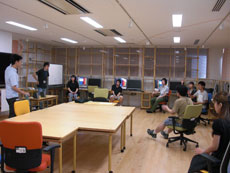 |
II. Trial Content for Science Communication
Instructors: Hiroshi ITSUMURA, Chihomi SANNAMI
Science communication is an activity that seeks two-way communication between scientists and society. In this practicum, participants will learn science communication through planning, producing and developing content for science communication in with respect to a given subject and goal. The participants will set goals for communication, gather data, plan content and create media. They will learn skills for presenting their plans and achievements as well. |
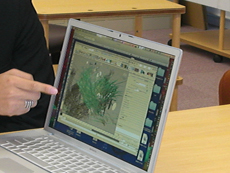 |
III. Developing Digital Content that leads to Knowledge and Emergence
Instructors: Teiichi NISHIOKA, Sangtae KIM
In this practicum, participants will create digital content for interactive learning in a high-definition and high resolution interactive media environment. Prof NISHIOKA will teach planning of content for next-generation filming (digital media theory). Prof. KIM will give instruction in planning and design of content to promote deeper understanding, and active discussion about digitization (information design). Using the techniques of workshop design, consideration will be given to methods needed to allow students from different fields to collaborate. Participants will be divided into two groups, each being made up of students from different fields collaborating. They will do planning, production and presentation of content in groups. |
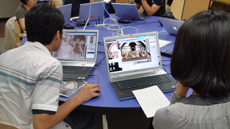 |
IV. Virtual 3-D Design and Realization
Instructor: Jun MITANI
In this practicum, participants create 3-D graphic data on a computer, then realize it as a physical object that we can actually touch. They will use 3D-CG and 3-D CAD software to design the 3-D graphic object. Then they will either use a 3-D printer (a molding device using the laminating method) or a paper model to realize it as a physical object. The 3-D printer prints complicated 3-D objects in one piece to save worrying about the assembly. On the other hand, with the paper model, there is a need to express the object as a set of objects extensible to planes, eg., a cylinder, a cone or a tangential surface. By understanding the differences in these realization methods, participants can make a design for the appropriate shape and attempt to efficiently make the shape they want. This practicum course involves four days of intensive training, including conceptual capturing and analysis of the object to be recreated, instruction in the use of software to create 3-D graphic objects, demonstration of the 3-D printer, a brief instruction of the science of figures and production of the paper models. |
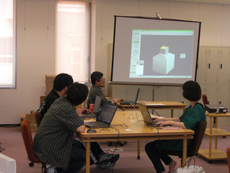 |
V. Production of Electronic Works and Development of Private Internet Exhibit
Instructor: Hotaka TAKIZAWA
With the recent development of information technology, especially the Internet, users can not only receive and browse content on the Internet, but they can also produce content, transmitting and posting it for the whole world to see. Though using a web browser to view content is easy to do, in order to transmit information, students must learn how to create content, understanding how the Internet works, as well as many other technical elements. In this track, participants will study basic methods for using software for production and processing to create electronic works such as images, movies and virtual sculptures. They will learn how to produce these kinds of electronic works alone or together with students from various backgrounds. In addition, they will acquire the ability to create a website exhibit to display their works. We plan this track to be taught by a university instructor and an outside lecturer. |
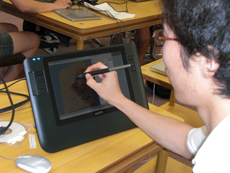 |
VI. Design and Development of an Interactive Digital Photo Frame
Instructor: Tomoo INOUE
Information is becoming more and more ubiquitous in society. In the near future, it seems that most of our personal belongings will be equipped with information processing capability through computers. However, the design norms have not been established. In this practicum, students will take part in the design and development of a digital photo frame, a good example of computerization. An interactive digital photo frame will be created using a sensor kit, etc., allowing for a different approach than that of the traditional photo album. During the course of the practicum, it will be necessary to gain knowledge of interactive design in relation to ease of use, knowledge of digital control data, knowledge of the content itself as well as knowledge of intellectual property rights for the content that is used. Participating students will each take one of the abovementioned areas as their specialty, but will also work together to solve these problems mutually. In this way, they will get the opportunity to learn how to work in a cooperative manner. |
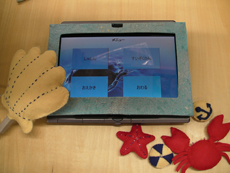 |
VII. Manga Portal / Manga Mall
Instructor: Shigeo SUGIMOTO
This practicum will create a Manga portal that will offer information regarding Manga. To make the Manga portal, the participants will discuss what kind of information should be offered in regard to Manga and how the information and Manga should be presented. Then, the participants will define the information about Manga, i.e. metadata for Manga, and/or presentation method of Manga. In this practicum, participants can choose metadata intensive course or Manga presentation intensive course. In either of the courses, first students will be asked to do brainstorming to determine their goals. This practicum class will be carried our in cooperation with the Kyoto International Manga Museum and the College of Manga at Kyoto Seika University in part. |
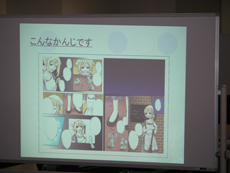 |
VIII. Interaction between Man and Robots
Instructor: Masahiko MIKAWA
The goal of this practicum course is to provide the participants with opportunities to think about human-to-human and human-to-robot communication and interaction through experimental development of a librarian robot. In this course, we use a robot (an arm manipulator) that has visual, audio and natural language speech capabilities. The participants will take a few typical tasks of librarians, including the receptionist function based on human behavior prediction, user interaction function based on natural language dialog function and a navigation function by gesture. In this course, the participants will be divided into planning and development teams and study the process of product development. At the same time, they will learn the wonders of human intelligence.
The basic functions were created in 2008. In 2009, we plan to add more functions and improve on those we already have. In this practicum, the class will be divided into a planning team and a development team to learn the process of product development. At the same time, the wonders of human intelligence will be studied. We are looking for students who have an interest in communication and interaction, programming, computer embedding technology and library duties, etc (even one of these is fine). Even someone who knows nothing about programming is welcome. This track involves a wide variety of things, from software to hardware, from human to mechanical (robot), the humanities, and from art to engineering. |
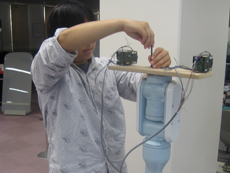 |
IX. Producing Media Art Works by Physical Computing
Instructor: Fumiaki MURAKAMI
We will not only complete virtual spaces in the computer, but we will produce a media art work that relates to our physical living space. Specifically, we will connect many kinds of sensors and actuators (LED, motorized, etc.) to the computer, allowing us to propose and produce works that involve mutual integration on the part of the viewer and the computer. The origin of the word ‘art’ is the Latin word ‘ars’, which the ancient Romans translated from the Greek word ‘techne’. In other words, art and technology were one and the same, but they have gone their separate ways in our modern culture. Media art seeks to fuse these two back together, trying to create a new relationship between man and technology. In the first half of the practicum, media art works will be introduced, including a description of their technical side, as well as a consideration of the expression of the central theme of the works. After that, we will produce a work in the workshop, learning the basics of electrical circuits and programming. Finally, presentations of the works will be made by groups or individually. |
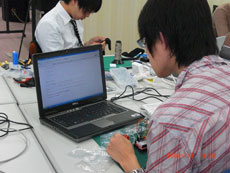 |
|
|
|
|
 |